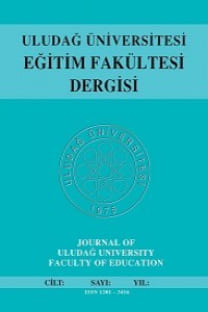Beden Eğitimi Öğretmenlerinin Fiziksel Aktivite Düzeylerinin Araştırılması
Çalışmamızın amacı, Bursa’da görev yapan Beden Eğitimi Öğretmen- lerinin Fiziksel Aktivite (FA) düzeylerini belirlemek. Bu çalışmaya 25- 65 yaş arasında olan toplam 250 beden eğitimi öğretmeni katılmıştır. Fiziksel aktivite seviyesini belirlemek için Uluslararası Fiziksel Aktivite Anketi (IPAQ) uygulandı. FA seviyeleri inaktif, minimum aktif ve HEPA aktif grupları olarak MET yöntemiyle belirlenmiştir. BEÖ’nin yaş, cinsiyet, VKİ, medeni durum, çocuk sayısı, alkol ve sigara içme durumlarına göre FA düzeyleri belirlendi. Elde edilen bulgularının değerlendirilmesinde Ki-kare testi kullanılmıştır. Çalışmaya katılanlarının fiziksel aktivite süresi ortalama olarak 1380,16 min/hf ve % 41,6’sı inaktif, % 41,6’sı minimum aktif ve % 16,8’i HEPA aktif tir. Sonuç olarak beden eğitimi öğretmenlerinin fiziksel aktivite seviyeleri yetersiz ve inaktivite yaygın odluğunu söylenebilir
Anahtar Kelimeler:
Fiziksel aktivite, beden eğitimi öğretmeni
Beden Eğitimi Öğretmenlerinin Fiziksel Aktivite Düzeylerinin Araştırılması
Keywords:
-,
___
- Atenz, A.A. A review of empirically based physical activity program for middle aged to older adults. Journal of Aging and Physical Activity, 9. 2001: 38- 55.
- Barros, M.V. and Nahas M.V. Health risk behaviors, health status self-assesment and stres perception among industrial worker, Rev. Saude Publica. 35. 2001: 554-563.
- Bauman, A. Updating the evidence that physical activity is good for health – An epidemiological review 2000-2003, J. Sci.Med.Sport 7 (suppl.). 2004: 6- 19.
- Bell, A.C., Ge, K. and Popkin, B.M.. The road to obesity or the path to prevention: monitorized transportation and obesity in China. Obes. Res. 10. 2002. 277-283.
- Berlin, J.A. and Golditz, G.A. A meta analysis of physical activity in the prevention of coronary heart diseases. Am. J. Epidemiol. 132. 1990: 612-628.
- Blair, S.N., Goodyear, N.N., Gibbons, L.W., Cooper, K.N. Physical Fitness and İncidence of hypertansyon in healthy normottensive men and women. J. Am. Med Assoc. 252. 1990. 487-490.
- Brady, F. The Role Of Physıcal Actıvıtıes Throughout The Lıfespan: Implıcatıons For Counselors And Teachers , By:, Journal of Humanistic Education & Development. Vol. 36, Issue 4. 1988: 19.
- Burton, N.W. and Turrell, G. Occupation, hours worked , and leisure – time physical activity. Prev. Med. 31. 2000. 673-681.
- Cauley, J.A., Donfield, S.M., Laporte, R.E., Warhaftig, NE. Physical activity by sosyoeconomic status in two population based cohorts. Med. Sci.Sports Exerc. 23. 1991. 343-351.
- Craig, C.L, Marshall, A.L., Sjöström, M., Bauman, A.E., Booth, M.L., Ainsworth, B.E., Pratt, M., Ekelund, U., Yngve, A., Sallis, J.F., Oja, P. International Physical Activity Questionnaire (IPAQ): 12-country reliability and validity. Med Sci Sports Exerc. 35. 2003. 1381-1395
- Hallal, P.C., Vıctora, C.G., Wells, J. C. K., Lıma, R.A.C. Physical Inactivity: Prevalence and Associated Variables in Brazilian Adults. Medicine & Science in Sports & Exercise. Vol. 35 Issue 11. 2003. p1894, 7p.
- Katzmarzyk, P.T., Gledhill, N., Shephard, R.J. The economic burden of physical inactivity in Canada. Can. Med.Assoc. J. 163. 2000. 1435-1440.
- Kreska, A.M. and Caspersen, C.J. Introduction to collection of physical activity questionnaires. Med.Sports Exerc. 29. 1997.: 5-9.
- Laporte, R.E., Montoye, H.J., and Caspersen, C.J. Assesment of physical activity in eğidemiologic research; problems and prospects, Public Health Rep. 100. 1985. 131-146.
- Lee, I.M. Physical Activity, fitness and cancer. In: Bouchard, c, Shepard, RJ, Stephens, T, eds. Physical Activity, fitness and health: International, Proceedings and Consensus Statement. Champaign IL. Human Kinetics, 1994: 814-831.
- Manson, L.E., Nathan, D.M., Krolewski, A.S., Stampfer, M.J., Willett, W.C., Hennekens, C.H.. A prospective study of exercise and incidence of diabetes among US male physicians. JAMA. 268. 1992. 63-67.
- Manson, J.E., Rimm, E.B., Stampfer, M.J., et al. Physical activity and incidence of noninsulin dependent diabetes mellitus in women. Lancet. 1991: 338: 774-778.
- Martin, S.B., Morrow, J.R., Jackson, A.W., Dunn. A.L. Variables related to meeting the CDC/ACSM physical activity guidelines. Med.Sci.Sports Exerc. 32. 2000: 2087-2092.
- Murray, C.J.L. and Lopez, A.D. Mortality by cause for eight regions of the world: global burden of disease study. Lancet. 349. 1997. 1269-1276.
- Pereira, M.A, Folson, A.R., Mogovern, P.G., et al. Physical activity and incident hipertansyon in black and white adults: the arteriosclerosis Risk in Communities Study, Prev. Med. 28. 1999. 304-312.
- Pıvarnık, J. M., Reeves, M.J., Rafferty, A:P. Seasonal Variation in Adult Leisure- Time Physical Activity. Medicine & Science in Sports & Exercise. Vol. 35 Issue 6, 2003. p1004, 5p.
- Salonen, J.T., Puska, P., Toumilehto, J. Physical Activity and risk of myocardial infarction, celebral stroke and death: a longitudinal study in Eastern finland. Am. J. Epidemiol. 115. 1982;. 526-537.
- Stewart, A.I. Community – based physcal activity programs for adults age 50 and older. Journal of Aging and Physical Activity, 9. 2001 71-91.
- WHO Consultation on Obesity. Obesity: Preventing and Managing the Global Epidemic. Geneva, Switzerland: World Health Organization; WHO Technical Report Series 894. 2000
- Study on The Physical Activity Level of Physical Education Teachers
- Başlangıç: 1986
- Yayıncı: Bursa Uludağ Üniversitesi Eğitim Fakültesi
Sayıdaki Diğer Makaleler
Tamer KUTLUCA, Osman BİRGİN, Hakan ÇATLIOĞLU
Kodály Yöntemi ve İlköğretim Müzik Derslerinde Kodály Yöntemi Uygulamaları
Beden Eğitimi Öğretmenlerinin Fiziksel Aktivite Düzeylerinin Araştırılması
Diğdem Müge SİYEZ, Ferda AYSAN
Yaz Spor Okulları İle Çocukların Benlik Saygısı Arasındaki İlişki
Faruk KORKMAZ, Nimet Haşıl KORKMAZ, Güven ÖZKAYA
19. Yüzyıl Avrupa Resminde Zaman Kavramının Anlamsal Değişimi
